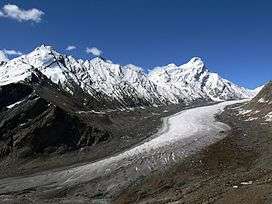Drang-Drung Glacier
The Drang-Drung Glacier (also called Durung Drung Glacier) is a mountain glacier near the Pensi La mountain pass at the Kargil - Zanaskar Road[1] in the Kargil district of Ladakh in India.[2]
| Drang-Drung Glacier | |
|---|---|
 Drang-Drung Glacier | |
| Type | Mountain glacier |
| Location | Himalaya Range, Zanskar Range, Pensi La, Ladakh |
| Coordinates | 33°45′18.77″N 76°18′3.47″E |
| Length | 23 kilometres (14 mi) |
The Drang-Drung Glacier is likely to be the largest glacier in Ladakh other than the Siachen Glacier in the Karakoram Range,[3] with a maximum length of 23 kilometres (14 mi)[4] at an average elevation of 4,780 m (15,680 feet). The glacier lies in the northeastern Himalayan Range known as the Zanskar Range, 142 kilometres (88 mi) south of Kargil and 331 kilometres (206 mi) east of Srinagar, the capital of Jammu and Kashmir.[5]
The Drang-Drung Glacier is a long river of ice and snow, a source of the Stod River[2] which is a tributary of the Zanskar River and the Zanskar River is a tributary of Indus River.[6] Doda Peak with an elevation of 6,550 m (21,490 feet) rises from the glacier.[7]
Access
The Drang-Drung Glacier is accessible from Srinagar or Srinagar Airport in two days, 331 kilometres (206 mi) by car or bus which leads by NH 1D, a national highway which connects Srinagar and Leh through the towns of Ganderbal, Kangan, Sonamarg, and Dras. Kargil town is at the half-way point.[8] From Kargil the glacier lies on the right side of Kargil-Zanaskar Road[1] which passes through a gorge valley of Suru River and under the shades of two mountain peaks of Nun and Kun. After crossing the Pensi La mountain pass a trek of one day[1] from the road leads to the head of Drang-Drung Glacier. The road is only open to traffic from May–September due to heavy snowfall at Zojila and Pensi La passes, and the best time to visit is July to August.[9][5]
References
- Prem Singh Jina (1996). Ladakh: The Land and the People. Indus Publishing, 1996. p. 35. ISBN 978-81-7387-057-6. Retrieved 12 July 2012.
- Janet Rizvi (1996). Ladakh: Crossroads of High Asia. Oxford University Press, 1996. p. 30. ISBN 978-0-19-564016-8. Retrieved 12 July 2012.
- Jasbir Singh (2004). The Economy of Jammu & Kashmir. Radha Krishan Anand & Co., 2004. p. 223. ISBN 978-81-88256-09-9. Retrieved 12 July 2012.
- "Zanskar Range". himalayanclub.org. Retrieved 12 July 2012.
- "Zanskar". rang7.com. Archived from the original (pdf) on 6 October 2014. Retrieved 12 July 2012.
- "Stod a tributary of Zanskar river". tourisminjammukashmir. Archived from the original on 24 July 2012. Retrieved 12 July 2012.
- "Expeditions and notes". himalayanclub. Retrieved 12 July 2012.
- Prem Singh Jina (2000). Ladakh: Past and Present. Gyan Books, 2000. p. 96. ISBN 978-81-212-0654-9. Retrieved 12 July 2012.
- "Ladakh, Zanskar, Nubra, Kargil". travel.kashmironline.net. Retrieved 14 July 2012.
- Drang Drung